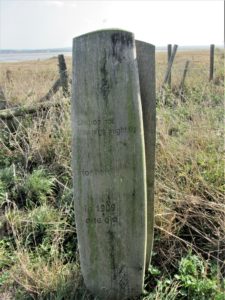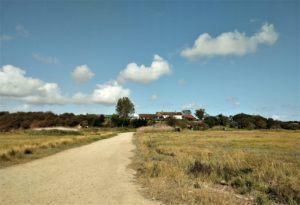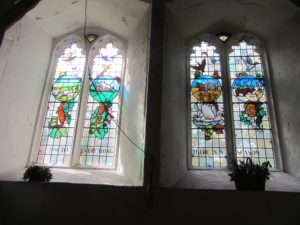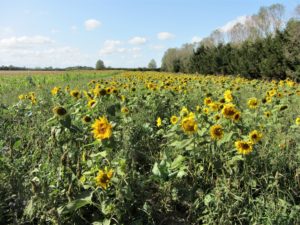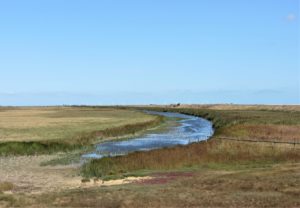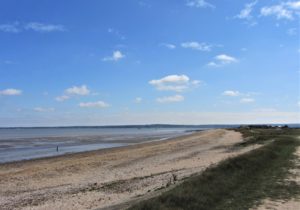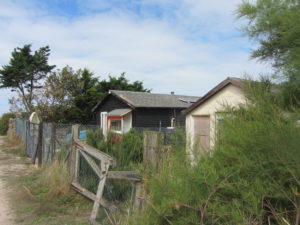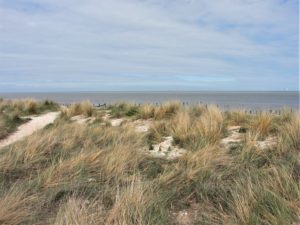In September my husband, son and I went for another walk on the Isle of Sheppey in Kent. This time, instead of our favourite Elmley National Nature Reserve, we decided to try a different reserve – the Swale Nature Reserve – which is reached on foot either from near Harty church or from the Reserve’s car park at Shellness. Harty was once an island and is still called the Isle of Harty and it’s a fascinating place. We drove to the Harty Ferry Inn and parked in their large car park in the hope of being able to get a bar meal before we set off. Unfortunately the pub had changed hands since we were last there so only set lunches were available; the menu sounded lovely but would have taken up too much of our time, so we just had drinks sitting in the pleasant garden overlooking the waters of the Swale. Afterwards we walked down to the edge of the water to see where the Harty ferry once operated across The Swale to Oare, near Faversham, then we moved the car and parked it outside Harty’s little church of St Thomas the Apostle, and had a quick look inside. At the back of the church there are a couple of benches with lovely views down to the water and across to the north Kent mainland. Setting off in an easterly direction to the end of the road we then turned left onto a track. A short way along there were lots of sunflowers blooming along the edge of a field, and we saw many more on our walk, presumably they were planted to provide food and cover for game birds. A belt of trees showed where the footpath started and it led us towards The Swale; on the way we saw more fields of sunflowers and distant views of the wind farms between Kent and Essex. Just as we were going to enter the gate onto the Swale Nature Reserve we saw an information board about the reserve and behind that I noticed a wooden marker with the following words `caution … not that pigs might fly … for here in 1909 … one did`.
I knew that this area was important in aviation history as the first powered flight by an Englishman from British soil took place here in 1909 when J T Claude Moore-Brabazon achieved 50 feet of powered flight before crashing, however, I’d not heard anything about a pig flying! Later, I looked it up and apparently, while preparing for a mile long flight around a measured circuit on the Island to try to win a Daily Mail prize of £1000 for the first Briton flying a British plane the story goes that Moore-Brabazon heard a bystander say that the chance of him succeeding was `as likely as a pig to fly`. Six days later he tied a piglet (named Icarus II) in a basket with a sign on it saying `I am the first pig to fly`, attached it to one of the struts of his aircraft and took off on his flight. The following year he was awarded the first British pilot licence.
We continued along the path through the nature reserve, with the waters of The Swale to our right and acres of marshland with strange raised areas, like spoil heaps, to our left. We looked on our OS map and saw the words `saltworks` so presumably the heaps must have been something to do with that. This is typical marshland with ditches and ponds, reeds, grassland and flooded areas and in the distance we saw some large birds on a bank – swans, ducks, moorhens and what appeared to be cormorants or shags; once we got closer we identified them as four shags, but this was the only wildlife we saw on the reserve that day. We walked as far as the hide and peered out hoping to see more birds but there was nothing about, apart from grazing cows. We decided not to walk the remaining 2+km to Shellness as it was quite windy, so we turned around and went back the way we had come. In calmer weather we’ll do a circular walk.
We then drove down to Shellness to show my son what the other end of the reserve looked like, passing the RSPB Raptor Viewpoint on the way to the Leysdown Road (made a note to visit this some time). Leysdown is a slot machines and fish and chips kind of place and some people are a bit unkind about it but this was the last chance I had to find a public toilet, and I was plesantly surprised that the one near the beach had a friendly attendant on duty so it was very clean. Once away from the mobile homes and caravans the road leads past Muswell Manor and the statue of the three Short brothers who, in 1909, opened Shellbeach Aerodrome on flat ground along the edge of The Swale and set up the first aircraft production line in the world to make 6 Wright Flyers under licence. Mussel Manor, as it was then, became home to an Aero Club and there’s a famous photo that was taken there in May 1909 of the Wright brothers, Shorts, Charles Rolls and members of the Aero Club. It wasn’t long before production, the airfield and the Royal Aero Club moved to a larger site at Standford Hill, Eastchurch; a Naval Flying School was also set up and over the years and after many reincarnations became RAF Eastchurch, until it closed in 1946. Some of the old buildings and hangars remain and this is now the site of Eastchurch Aviation Museum, run by volunteers and well worth a visit.
It was a sunny day and from the top of the seawall the beach looked beautiful – white sand and shells with a backdrop of blue sea and sky and views across to Whitstable on the mainland; when the tide is out it’s a wonderful area for wading birds as there is mud and plenty of shell fish. On the edge of the beach near Shellness is a row of old beach holiday huts/homes, some dating back to the 1920s; several are now in the process of being modernised and one has already been turned into an up-market holiday rental. However, there appears to be no water supply so everyone has to have rainwater collection tanks, which might be ok for weekend stays but perhaps not quite so good for permanent homes, especially as it’s a very dry area. Annoyingly (as far as I’m concerned) the best part of the beach is designated a naturist beach. At the very end of the point the private estate of the hamlet of Shellness means there’s no public access to a WW2 post (antisubmarine) so the only way to get there `legally` is to walk round on the beach at low tide.
Worth a visit nearby: Memorial to the Home of Aviation in Eastchurch village, the Aviation Museum (Wrights Way off Brabazon Rd., Standford Hill, Eastchurch, ME12 4AA) with the Old Mill Cafe run by prisoners nearing release opposite the Aviation Museum.
